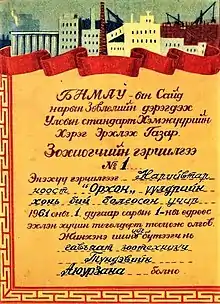 Orkhon sheep breed, Selenge Province, Mongolia | |
| Country of origin | Mongolia |
|---|---|
| Distribution | Mongolia |
| Use | Wool |
| Traits | |
| Weight |
|
| Skin color | white |
| Wool color | white |
| |
The Orkhon (Mongolian: орхон) is a Mongolian breed of sheep first developed in 1961. This medium, semi-fine wool breed is now reared primarily for wool.
History
In 1942 then-Council of Ministers (Cabinet) of Mongolia issued a resolution to develop domestic fine and semi-fine wool breeds to meet the increased national manufacturing demand. Selection and breeding works started in 1942 with successive cross-breeding of Soviet Tsigai and Altay rams.

The first certificate confirming the breed was issued on January 1, 1961, by then-Standards and Measurements Authority of People's Republic of Mongolia to the breed's developer, researcher and veterinarian T.Ayurzana (1910-1972).[1][2]
Characteristics
Both sexes of Orkhon breed display white color, short tail (usually cut at early age), compact body with straight back. On average and at maturity, rams produce 5,6 kg and ewes produce 3,7 kg of semi-fine wool. Average wool length is 8 cm, the average diameter of the Orkhon fiber is 25-31 microns.
Approximately 1.15 lambs per litter. Age at first breeding is 18 months, average liveweight at birth is 4 kg for males and 3.6 kg for females.
This is hardy sheep well suited for Mongolian harsh climate, grazed on pastures all year round.
Population
The current exact size of the Orkhon sheep population is unknown, but estimated at around 3500 heads as of 2018. The main stock of Orkhon breed is now kept in Selenge soum of Bulgan Province of Mongolia.

References
- ↑ Severt︠s︡ova, Institut ėvoli︠u︡t︠s︡ionnoĭ morfologii i ėkologii zhivotnykh im A. N. (17 January 1973). "Characteristics of the Development of Skin and Wool in Sheep: Changes Related to Growth". Indian National Scientific Documentation Centre – via Google Books.
- ↑ "Scientific World". 17 January 1965 – via Google Books.
External links
- Sheep breeds of Mongolia at UN FAO database